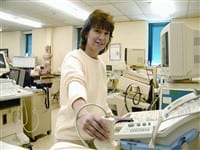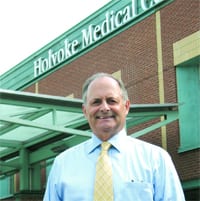CDH Works to Prevent Hospital Infections
NORTHAMPTON — As of the end of December, it has been 14 months since a Cooley Dickinson Hospital ICU patient has become sick with ventilator-associated pneumonia, a serious infection that can occur in people who rely on ventilator machines to breathe.
According to the Centers for Disease Control’s National Healthcare Safety Network Report, Cooley Dickinson’s accomplishment of preventing ventilator-associated pneumonia, or VAP, ranks the hospital’s performance in the top 10{06cf2b9696b159f874511d23dbc893eb1ac83014175ed30550cfff22781411e5} of the nation’s medical/surgical intensive care units (ICUs).
VAP can occur in patients who, because of severity of illness or condition, require mechanical ventilation. When the ventilator tube that pumps life-saving air into vulnerable lungs becomes contaminated, the tube can act as a pathway for bacteria or secretions to enter the respiratory tract, paving the way for VAP. According to the Institute for Healthcare Improvement, VAP typically afflicts up to 15{06cf2b9696b159f874511d23dbc893eb1ac83014175ed30550cfff22781411e5} of those in ICUs so weakened by illness or trauma that they need mechanical help to breathe.”
Physicians and staff at Cooley Dickinson are working toeliminate VAP and have adopted a zero-VAP philosophy. “We are being aggressive about eliminating VAP, and our track record demonstrates our commitment to delivering the highest possible care to our patients,” said Daniel J. Barrieau, director of respiratory care services.
This aggressive approach is paying off. Barrieau said VAP infections in Cooley Dickinson’s intensive care unit have gone from five in 2007 to zero in 2008.
“Anyone who is admitted to a hospital is at risk for a hospital-acquired infection,” said Dr. Joanne Levin, medical director of infection prevention at CDH. “At Cooley Dickinson, our teamwork to eliminate VAP comes from a commitment to providing the best care for each patient. The entire organization is focused on continuously improving patient safety and decreasing hospital-acquired infections.”
“In addition to searching for the best clinical solutions tothe VAP problem, we asked ourselves, ‘what can we change about our culture and our systems to improve our outcomes?’” said Barrieau.
This culture shift started in 2005 when a team of respiratory therapists, physicians, nurses, quality-improvement staff, and infection prevention specialists adopted a set of instructions known as the IHI ventilator bundle. It offers a series of interventions determined to be the best evidence-based practices related to reducing the risk of VAP to patients.
Then, Barrieau explained, staff began to “push beyond the bundle of strategies to look for other ways to reduce the risk to patients and eliminate VAP altogether.”
They scrutinized the VAP cases to identify patterns and trends. For example, their analysis indicated that patients on ventilators for more than 19 days, those with difficult intubations, and those who required transportation within the hospital were the most vulnerable.
Using an approach called clinical microsystems in which front-line teams are empowered to make improvement decisions based on scientific data and best practices, the team evaluated how each clinician relates their daily work and actions to VAP.
“Doing the minimum is not enough to achieve our zero-VAP philosophy,” said Barrieau. He says clinicians in a culture of zero VAP understand how their actions matter and that acting to reduce risk is part ofthe clinician’s standard practice.
In addition to preventing VAP infections in patients and providing best-practice care, there is a significant cost savings to the hospital. In 2007, based on Cooley Dickinson’s VAP-prevention measures, the organization saved $200,000 by reducing or eliminating the occurrence of the infection and reducing the patient’s length of stay in the intensive care unit.


